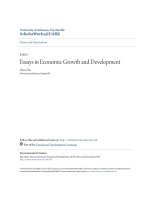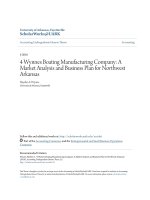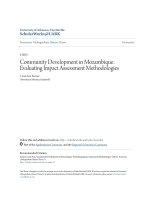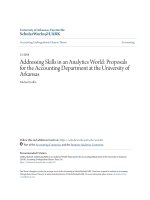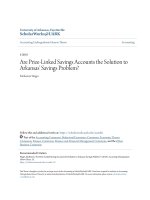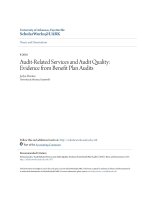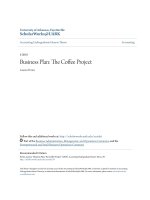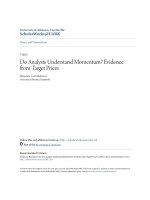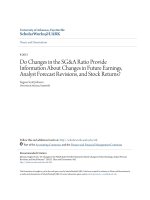Accounting undergraduate Honors theses: Does corporate inversion lead to tax savings?
Bạn đang xem bản rút gọn của tài liệu. Xem và tải ngay bản đầy đủ của tài liệu tại đây (196.66 KB, 23 trang )
University of Arkansas, Fayetteville
ScholarWorks@UARK
Accounting Undergraduate Honors Theses
Accounting
5-2015
Does Corporate Inversion Lead to Tax Savings?
Nathan P. Downs
University of Arkansas, Fayetteville
Follow this and additional works at: />Part of the Accounting Commons
Recommended Citation
Downs, Nathan P., "Does Corporate Inversion Lead to Tax Savings?" (2015). Accounting Undergraduate Honors Theses. 17.
/>
This Thesis is brought to you for free and open access by the Accounting at ScholarWorks@UARK. It has been accepted for inclusion in Accounting
Undergraduate Honors Theses by an authorized administrator of ScholarWorks@UARK. For more information, please contact ,
Does Corporate Inversion Lead to Tax Savings?
By
Nathan Downs
Advisor: Dr. Karen Pincus
An Honors Thesis in partial fulfillment of the requirements for the degree of Bachelor of
Science in Business Administration in Accounting
Sam M. Walton College of Business
University of Arkansas
Fayetteville, Arkansas
May 8, 2014
1
Introduction
In August 2014, the unexpected announcement of Burger King’s plan to move its
corporate headquarters to Canada through their merger with Tim Horton’s drew ire from not only
members of Congress, but also the president himself. In a direct response to Burger King and
other U.S. corporations who might be contemplating similar corporate inversions, the White
House vowed to issue an executive order to curb companies from escaping taxes by taking up
residence in a foreign nation. While the inversion controversy has been reported upon
intermittently for many years, the recent activities of high-profile companies like Burger King
and Pfizer has led to more press on this subject. So what is corporate inversion and why has it
caused so much dissension?
A corporate inversion occurs when an American corporation acquires or merges with a
foreign-domiciled company. As a result, the corporate structure of the American company
becomes “inverted” by legally altering its place of incorporation. The foreign company becomes
the legal parent company through the transaction, and shares of the former U.S. company are
typically converted to shares of the newly formed entity. However, significant changes in
operations rarely accompany corporate inversions (Seida & Wempe, 2004). The newly formed
entity continues to function as it did pre-inversion, specifically the physical locations of its U.S.
facilities, employees, and operations. In addition to the official change of address, there can be
legal and regulatory ramifications. For example, an inverted U.S. firm listed on the New York
Stock Exchange could choose to adhere to “International Financial Reporting Standards” (IFRS)
instead of U.S. “Generally Accepted Accounting Principles” (GAAP).
In many instances, the foreign entity was incorporated in a nation that levies a corporate
income tax at a low or nil rate, otherwise known as a tax haven. Furthermore, as noted in the
2
inversions of Weatherford International, Aon Corporation, and Cooper Industries the foreign
company was initially registered and established as a subsidiary of the American company itself.
This form of inversion is known as a “naked inversion” since it does not demand any major
changes in control due to the prior associations of the two companies.1
The primary motivation behind a corporate inversion is simple, to reduce a corporation’s
tax burden. It is believed that corporate inversions lead to lower effective tax rates, improved
cash flows, and overall higher earnings that gives American companies the competitive
advantage to thrive in a globalized economy. On July 18, 2014, chief executive officer of Abbott
Laboratories, Miles White, defended corporate inversions in an op-ed piece in the Wall Street
Journal. He is quoted as saying, “In terms of global competitiveness, the U.S. and U.S.
companies are at a substantial disadvantage to foreign companies. Taxes are a business cost. Our
disproportionately higher tax rate puts foreign companies at a huge advantage competitively.”
This rationale is shared among executives of American companies who have chosen to invert.
The supposed improvement in financial performance through the result of inversions is
congruent with the beliefs of profit-motivated organizations.
Another reality of corporate inversions is the relocation to nations who abide by a
territorial tax system. This type of tax system only taxes income that is derived from the nation in
which it is earned. However, the U.S. subjects its corporate residents to residential taxation. In
this less common system, a corporation owes taxes on all worldwide income regardless of where
the income is sourced. In theory, an American company is liable for U.S. tax on profits it claims
were made offshore if it wants to repatriate the money back domestically. However, once a
1
There has been legislation passed to prohibit this form of inversion, and is further discussed on page 4.
3
corporation reincorporates as foreign, the profits it claims were earned for tax purposes outside
the U.S. become fully exempt from U.S. tax.
Even though a foreign corporation still owes U.S. tax on profits it reports were earned in
the U.S., corporate inversions are often followed by the practice of “earnings-stripping”. The
corporation makes its remaining U.S. profits appear to be earned in other countries in order to
avoid paying U.S. taxes on them. For example, a corporation can do this by encumbering the
American part of the company with debt owed to the foreign part of the company. The “interest
payments” on the debt are tax deductible, officially reducing American profits, which are
effectively shifted to the foreign part of the company. This method was popular for many years
before the “Revenue Reconciliation Act” was passed in 1989. This bill led to the addition of
Section 163(J) to the IRS Code in an effort to curb abusive earnings-stripping strategies. This
section disallows the deduction of interest expense if the ratio of debt to equity of the corporation
exceeds 1.5:1 (26 USC §163j).
Recently, a common method being used to employ earnings-stripping are royalty
payments. Let’s say that the foreign segment of a corporation owns the rights to intellectual
property such as a patent for a product. They will then grant the American part of the company
the right to sell this patented product. In return, they will have pay an agreed upon amount for
this right, otherwise known as a royalty. Royalty payments are an effective mechanism to reduce
American taxable income since they’re classified as an expense. The foreign part of the company
continues to receive all of the profits from this exploitation, meanwhile they shift their tax
burden to lower taxed jurisdictions.
In 2004, Congress passed the “American Jobs Creation Act” which included legislation to
crack down on inversions. Moreover, this bill annexed Section 7874 to the IRS Code. Section
4
7874 contains certain requirements in order for a U.S. corporation to reincorporate to a foreign
tax jurisdiction. If the company fails to meet any of these requirements, it will be treated and
deemed as a U.S. corporation for tax purposes. First, the foreign corporation must “substantially”
acquire all of the properties of the U.S. corporation (26 USC §7874a). Second, after the
acquisition, the former U.S. company’s shareholders cannot hold more than 80% of the new
company (26 USC §7874a). However, if the former U.S. company’s shareholders own at least
60% but still less than 80% of the new company the inversion is subject to a certain stipulation.
The government will recognize the legitimacy of the inversion, but the corporation is subject to a
ten year penalty that taxes the entity on all “inversion gains”. Lastly, the U.S. company must
have “substantial business activities” in the jurisdiction where it wishes to relocate (26 USC
§7874a). In 2006, an addendum was added to Section 7874 defining substantial business
activities. The newly formed company must have at least 10% of its employees, property, and
income in the country where it relocates its corporate residence. This requirement was seen as
the biggest obstacle for corporations who desired to invert. Especially, if the inversion
destination was somewhere like the Cayman Islands or Bermuda. Nevertheless, many corporate
inversions still were able to pass this business activity test. Consequently, this resulted in an
amendment to the statue. In 2012, the activity requirement was increased to 25% in an effort to
further curb inversions.
The number of corporate inversions has grown exponentially over the last decade mainly
due to an antiquated tax code and partisanship in Congress. Since 1983, seventy-six corporate
inversions have taken place, with 47 of those occurring in the last decade. Countries such as the
Cayman Islands and Bermuda that do not tax corporate income were attractive destinations for
inverting firms prior to anti-inversion legislation. In recent years, nations like the United
5
Kingdom have become popular due to the combination of favorable tax rates and the ability to
meet the business activity test. The Joint Committee on Taxation estimates that corporate
inversions could cause $34 billion in lost tax revenue over the next ten years (Barthold, 2014).
Politicians and economists alike have scrutinized this practice stating that many of these U.S.
corporations who have inverted or plan to invert are heavily dependent upon America’s
infrastructure and property laws. Therefore it becomes easier to understand why this
controversial practice has drawn condemnation, with President Obama even going as far as
calling corporate inversions an “unpatriotic tax loophole” (Obama, 2014).
Corporations that choose to invert, argue that this action allows them to remain
competitive due to the nature of U.S. corporate tax rates. The U.S. corporate income tax rate
which is 35%, is considered one of the highest nominal tax rates in the developed world.
However, a study done by the Citizens of Tax Justice (non-partisan research group) found that
between 2008 and 2012 the average effective tax rate for U.S. corporations was 19.4%
(McIntyre, 2014). With certain industries such as utilities paying an average effective tax rate of
2.9% (McIntyre, 2014). This is a far cry from the 35% tax rate listed in the corporate tax
schedules. This raises the question; do U.S. companies really realize tax savings when they
perform an inversion?
This thesis investigates the tax implications of U.S. companies that employ the practice of
corporate inversion. I have selected eleven companies that have utilized this strategy, and have
conducted research to determine if corporate inversion results in a tax savings when compared to
a matched set of non-inversion companies. For my research, I will compare the tax liabilities of
the selected companies both before and after the inversion has occurred.
Methodology
6
I investigated the financial ramifications of corporate inversions using a sample of eleven
inversion firms and nine matched control firms (two matched firms were used more than once)
as seen in Table 1 and 2 below. The matched control firms were chosen by three sets of criteria.
First, the matched firm had to operate within the same industry of the inverted firm. To ensure
this, both firms had to have identical four digit SIC codes. The “Standard Industrial
Classification” (SIC) is a code used by U.S. government agencies to classify companies by
industry and common characteristics. However, all three matched firms for Cooper Industries,
Pentair Incorporated, and Eaton Corporation did not possess the same SIC code. These three
firms operate in a myriad of segments within Diversified Industrials, making it difficult to locate
a matched firm using the criteria described above. Therefore, I used Hoovers.com to select a
matched firm that operates as a direct competitor and offers similar product lines. Second, the
matched firm had to be within 20% of total revenue during the year of inversion, in comparison
to the inverted firm. Third, the matched firm had to be incorporated and legally domiciled in the
United States. In addition, the matched firms are aligned in time with the business of the
respective inverted firm.
Table 1: Sample of Inverted Firms
New Corporate
Name of Firm
Year of Inversion
SIC Code
Industry
Residence
Transocean
1999
Cayman Islands
1381
Oil & Gas Drilling
2001
Cayman Islands
1381
Oil & Gas Drilling
Incorporated
Global Marine
Incorporated
7
Oil & Gas
Weatherford
2002
Bermuda
3533
Machinery and
International
Equipment
Noble Corporation
2002
Cayman Islands
1381
Oil & Gas Drilling
Nabors Industries
2002
Bermuda
1381
Oil & Gas Drilling
Ensco International
2009
United Kingdom
1381
Oil & Gas Drilling
1999
Bermuda
6331
White Mountains
Fire, Marine, and
Insurance
Casualty Insurance
Insurance
Aon Corporation
2012
United Kingdom
6411
Brokerage &
Services
Electronic
Cooper Industries
2002
Bermuda
3670
Components &
Accessories
Special Industry
Pentair Incorporated
2012
Switzerland
3550
Machinery
Miscellaneous
Industrial
Eaton Corporation
2012
Ireland
3590
Machinery &
Equipment
Table 2: Sample of Matched Control Firms
Name of Firm
Name of Matched Firm
SIC Code
Industry
1381
Oil & Gas Drilling
Helmerich & Payne
Transocean Incorporated
Incorporated
8
Global Marine
Pride International
1381
FMC Technologies
3533
Oil & Gas Drilling
Incorporated
Oil & Gas Machinery and
Weatherford International
Equipment
Noble Corporation
Diamond Offshore Drilling
1381
Oil & Gas Drilling
Nabors Industries
Pride International
1381
Oil & Gas Drilling
1381
Oil & Gas Drilling
Helmerich & Payne
Ensco International
Incorporated
White Mountains
Fire, Marine, and
HCC Insurance Holdings
6331
Insurance
Casualty Insurance
Marsh & McLennan
Insurance Brokerage &
Aon Corporation
6411
Companies
Services
Industrial Instruments for
Cooper Industries
Danaher Corporation
3823
Measurement & Display
Pumps & Pumping
Pentair Incorporated
Flowserve Corporation
3561
Equipment
Industrial Machinery &
Eaton Corporation
Illinois Tool Works
3560
Equipment
This thesis examines whether a corporate inversion results in a reduction of the effective
tax rate. To test this, I took into consideration the firm’s pretax income, income tax provision,
and effective tax rate over a five year period. Furthermore, I sorted total revenue and pretax
income for each sample firm by domestic and foreign to see if there was any evidence of
earnings stripping post-inversion. The “inversion period” is defined as two years prior to the
inversion (Years 1 & 2), the year of inversion (Year 3), and two years following the inversion
(Years 4 & 5). The firm’s pretax income and income tax provision are both listed in the
9
consolidated statement of income found on form 10-K. This form is an annual filing required by
the U.S. Securities and Exchange Commission for public corporations. The tax provision is the
sum of both current and deferred income tax expenses. A deferred tax expense represents the
portion of the income tax expense that will be paid in future years. The deferred portion is
included because it is a bona fide expense and provides an accurate reflection of the total tax
burden.
As noted in the introduction, following many corporate inversions is the practice of
earnings stripping. In theory, this practice works in conjunction with a corporate inversion
because it results in the lowering of American pretax income. In turn, this should result in the
reduction of the effective tax rate. There are a myriad of methods in which earnings-stripping can
be employed. Admittedly, by only analyzing the information provided in the firm’s 10-K, I
cannot be absolutely certain of the exact method used to execute this practice. However, I can
conclude whether or not this practice was utilized by separating pretax income into U.S. and
foreign. I selected one firm per industry who I believed engaged in this practice, and calculated
U.S. and foreign pretax income as a percentage of total pretax income during the five year
period. I then compared the percentage of pretax income derived from the U.S. two years prior to
the inversion and two years following the inversion.
The effective tax rate is calculated by dividing the income tax provision by pretax
income. I calculated the effective tax rate over the five period for my sample of inverted and
matched firms. Moreover, I first compared the effective tax rates in the years following the
inversion to the years prior to the inversion to see if there were any material differences. Next, I
compared the effective tax rates of the inverted firms to their respective matched firms. The
purpose of this was examine the tax burden of an U.S. domiciled corporation similar in size and
10
operations in comparison to the inverted company. For further comparison, I calculated the
average effective tax rate by industry for the inverted and matched firms over the five year
period. I excluded any tax benefits (negative effective tax rates) from the calculation since it
significantly skews the average, and in all instances the benefit resulted from non-recurring
events unrelated to the inversion.
Oil & Gas Results
The effective tax rates for the six sample firms who operate in the Oil & Gas industry is
noted in Table 3 below. Using the data in Table 3, the average effective tax rate in the two years
following the inversion decreased by 9.5% in comparison to the average rates of years one
through three.
Table 3: Effective Tax Rates for Inverted Oil & Gas Companies
Pre-Inversion
Inversion Year
Post-Inversion
Year 1
Year 2
Year 3
Year 4
Year 5
10.9%
8.7%
-19.0%
25.4%
23.8%2
22.4%
26.7%
38.4%
11.1%
11.2%
46.2%
36.3%
44.3%
26.0%
21.5%
26.8%
24.6%
13.9%
11.0%
9.7%
Transocean
Incorporated
Global Marine
Incorporated
Weatherford
International
Noble
Corporation
2
Transocean was the only firm in all of my samples in which the ETR increased post-inversion. This could be in part
that a material amount of income was earned in higher taxed jurisdictions following the inversion compared to the
pre-inversion period. However, I cannot be certain since their 10-K’s did not provide a breakdown of sales or
pretax income by region.
11
Nabors
40.2%
35.9%
13.7%
-10.7%
9.9%
20.9%
17.3%
18.6%
14.9%
17.8%
27.9%
24.9%
25.8%
17.7%
15.7%
Industries
Ensco
International
Average ETR3
Meanwhile, Table 4 below, contains the effective tax rates for the four matched firms
who throughout the five year period are legally domiciled in the U.S.
Table 4: Effective Tax Rates for Matched Oil & Gas Companies
Year 1
Year 2
Year 3
Year 4
Year 5
35.7%
37.2%
39.6%
42.2%
39.6%
29.4%
31.6%
31.8%
30.0%
26.3%
25.1%
38.0%
29.0%
29.1%
26.6%
34.8%
34.9%
35.0%
10.7%
-105.0%
31.6%
31.8%
30.0%
26.3%
62.8%
Helmerich &
Payne
Incorporated4
Pride
International5
FMC
Technologies
Diamond
Offshore
Drilling
Pride
International6
3
Excluded Transocean Year 3 and Nabors Year 4 in the calculation of the average effective tax rate since both
companies incurred a tax benefit and neither tax benefit can be attributed to the inversion.
4
For the period between 1997-2001
5
For the period between 1999-2003
6
For the period between 2000-2004
12
Helmerich &
Payne
36.4%
36.5%
40.4%
34.7%
36.7%
32.2%
35.0%
34.3%
32.5%
32.3%
Incorporated7
Average ETR8
As evidenced by the data above and the graph below, the six inverted firms on average
benefited from the inversion especially in comparison to their respective matches.
Oil & Gas Sample
40.0%
Average ETR
35.0%
30.0%
25.0%
20.0%
15.0%
10.0%
5.0%
0.0%
Year 1
Year 2
Year 3
Year 4
Year 5
Inversion Period
Inverted Firms
Matched Firms
The decline in effective tax rates can also be attributed to the practice of earnings
stripping, which typically follows an inversion. As I said in the introduction, a corporate
inversion is just an official change of address and has minimal impact on operations. This should
result in the reorganized company still reporting a significant amount of income earned in the
U.S. following the inversion, which would essentially nullify the purpose of inverting since a
7
For the period between 2007-2011
Excluded Diamond Offshore Year 4 and Year 5 since there were pretax losses both years. Excluded Pride
International Year 5 (62.8%) due to non-recurring debt refinancing charges reducing income without a
proportional reduction to income taxes.
8
13
substantial portion of income would still be taxed at the same rates prior to redomestication.
Table 5 below, provides the percentage of reported sales and pretax income by U.S. and foreign
operations for Nabors Industries.
Table 5: Percentage of Sales and Pretax Income for Nabors Industries
Sales by Region
Pretax Income by Region
United States
Rest of the World
United States
Rest of the World9
2000
79.5%
20.5%
65.8%
34.2%
2001
84.0%
16.0%
83.3%
16.7%
200210
68.4%
31.6%
-20.0%11
120.0%
2003
61.0%
39.0%
-110.2%12
210.2%
2004
62.8%
37.2%
7.7%
92.3%
As you can see, U.S. sales accounted for at least 50% of total sales each year during the
five year period. However as noted in Table 3, Nabors’ effective tax rate notably decreased
following their inversion in 2002. Logically, this means that Nabors had to engage in some form
of earnings stripping to lower U.S. pretax income and shift those same earnings through intercompany means to a lower taxed jurisdiction. In 2004, Nabors’ foreign operations accounted for
only 37.2% of total sales as illustrated in Table 5. However, foreign operations accounted for a
staggering 92.3% of total pretax income during that same year. This resulted in an effective tax
rate of 9.9% in 2004.
9
Nabors’ 10-K’s did not provide a country by country breakdown of foreign pretax income. Nevertheless, the
assumption can be made that these foreign nations tax at a significantly lower rate.
10
The inversion occurred in 2002. The two years prior and subsequent represent the pre and post-inversion
periods respectively.
11
Reported a U.S. Pretax Loss of $28,157,000. However, reported total Pretax Income of $140,774,000.
12
Reported a U.S. Pretax Loss of $192,405,000. However, reported total Pretax Income of $174,623,000.
14
Insurance Results
The effective tax rates for the two sample firms that operate in the Insurance industry are
noted in Table 6 below. Using the data in Table 6, the average effective tax rate in the two years
following the inversion, decreased by 13.0% in comparison to the average rates of years one
through three.
Table 6: Effective Tax Rates for Inverted Insurance Companies
Pre-Inversion
Inversion Year
Post-Inversion
Year 1
Year 2
Year 3
Year 4
Year 5
39.4%
36.8%
32.9%
12.0%
41.3%
28.3%
27.3%
26.1%
25.4%
18.9%
33.8%
32.0%
29.5%
18.7%
18.9%
White
Mountains
Insurance
Aon
Corporation
Average ETR13
Meanwhile, Table 7 below, contains the effective tax rates for the two matched firms that
throughout the five year period stayed legally domiciled in the U.S.
Table 7: Effective Tax Rates for Matched Insurance Companies
Year 1
Year 2
Year 3
Year 4
Year 5
31.9%
32.8%
32.8%
40.2%
50.0%
HCC Insurance
Holdings
13
Excluded White Mountains Year 5 due to a pretax loss of $422,000,000 and tax benefit of $174,300,000 which
stemmed from the effects of deferred credit amortization, unrelated to the inversion.
15
Marsh &
McLennan
26.5%
30.1%
29.0%
30.1%
28.5%
29.2%
31.4%
30.9%
35.1%
28.5%
Companies
Average ETR14
As evidenced by the data above and the graph below, the two inverted firms on average
benefited from the inversion especially in comparison to their respective matches.
Insurance Sample
40.0%
Average ETR
35.0%
30.0%
25.0%
20.0%
15.0%
10.0%
5.0%
0.0%
Year 1
Year 2
Year 3
Year 4
Year 5
Inversion Period
Inverted Firms
Matched Firms
I selected Aon Corporation from my sample, to analyze whether there seemed to be any
evidence of earnings stripping following their inversion in 2012. Table 8, provides a percentage
of reported sales and pretax income by U.S. and foreign operations for the sample firm.
14
Excluded HCC Insurance Year 5 because the abnormally high effective tax rate was the result of a non-recurring
goodwill impairment charge related to their exit from the worker’s compensation service line of business. The
impairment was not tax deductible.
16
Table 8: Percentage of Sales and Pretax Income for Aon Corporation
Sales by Region
Pretax Income by Region
United States
Rest of the World
United States
Rest of the World
2010
39.9%
60.1%
2.0%
98.0%
2011
45.5%
54.5%
21.7%
78.3%
201215
46.3%
53.7%
34.0%
66.0%
2013
47.2%
52.8%
22.7%
77.3%
2014
48.4%
51.6%
-3.1%16
103.1%
As you can see, U.S. sales remained relatively constant throughout the five year period,
with a slight marginal increase the two years following the inversion. However as noted in Table
6, Aon’s effective tax rate notably decreased following their inversion in 2012. Sensibly, this
means that Aon had to utilize some form of earnings stripping to lower U.S. pretax income and
shift those same earnings through inter-company means to a lower taxed jurisdiction. Aon’s 10K’s did provide information segmenting foreign pretax income between the “United Kingdom”
and “other nations”. U.K. pretax income on average during the five year period accounted for
25% of foreign pretax income. Furthermore, the average corporate tax rate for the U.K. between
2010 and 2014 was 24.4%. This leads me to believe that Aon certainly could have benefitted
from shifting pretax earnings from the U.S. to domiciles like the U.K. and as a result reduce their
tax liability.
15
The inversion occurred in 2012. The two years prior and subsequent represent the pre and post-inversion
periods respectively.
16
Reported a U.S. pretax loss of $55,000,000. However, reported total pretax income of $1,765,000,000.
17
In 2014, Aon’s foreign operations accounted for 51.6% of total sales. Yet, foreign
operations accounted for an astounding 103.1% of total pretax income during that same year.
This resulted in an effective tax rate of 18.9% in 2014. As evidenced in the years prior to the
inversion, Aon probably had already been employing some form of earnings stripping.
Diversified Industrials Results
The effective tax rates for the three sample firms who operate in the Diversified
Industrials industry is noted in Table 9 below. Using the data in Table 9, the average effective
tax rate in the two years following the inversion, decreased by 5.9% in comparison to the average
rates of years one through three.
Table 9: Effective Tax Rates for Inverted Diversified Industrials Companies
Pre-Inversion
Inversion Year
Post-Inversion
Year 1
Year 2
Year 3
Year 4
Year 5
35.0%
32.1%
23.7%
20.8%
20.7%
32.4%
29.6%
43.1%
25.3%
22.6%
9.6%
12.9%
2.5%
0.6%
-2.4%
25.6%
24.9%
23.1%
15.6%
21.7%
Cooper
Industries
Pentair
Incorporated
Eaton
Corporation
Average ETR17
Meanwhile, Table 10 below, contains the effective tax rates for the three matched firms
who throughout the five year period are legally domiciled in the U.S.
17
Excluded Eaton Year 5 due to a tax benefit $42,000,000 mostly attributable to the Meritor and Triumph litigation
settlements and related legal costs. This realization was a non-recurring event and unrelated to the inversion.
18
Table 10: Effective Tax Rates for Matched Diversified Industrials Companies
Danaher
Year 1
Year 2
Year 3
Year 4
Year 5
38.0%
37.5%
34.0%
32.6%
29.5%
26.7%
27.0%
26.3%
29.5%
28.4%
31.0%
22.2%
30.8%
30.5%
30.0%
31.9%
28.9%
30.3%
30.9%
29.3%
Corporation
Flowserve
Corporation
Illinois Tool
Works
Average ETR
As evidenced by the data above and the graph below, the three inverted firms on average
benefited from the inversion especially in comparison to their respective matches.
Diversified Industrials Sample
35.0%
Average ETR
30.0%
25.0%
20.0%
15.0%
10.0%
5.0%
0.0%
Year 1
Year 2
Year 3
Year 4
Year 5
Inversion Period
Inverted Firms
Matched Firms
I selected Cooper Industries to see whether there seemed to be any evidence of earnings
stripping following their inversion in 2002. Table 11 below, provides a percentage of reported
sales and pretax income by U.S. and foreign operations for the sample firm.
19
Table 11: Percentage of Sales and Pretax Income for Cooper Industries
Sales by Region
Pretax Income by Region
Rest of the
United States
Rest of the World
United States
World18
2000
78.5%
21.5%
78.9%
21.1%
2001
77.0%
23.0%
67.0%
33.0%
200219
76.3%
23.7%
29.1%
70.9%
2003
73.5%
26.5%
16.2%
83.8%
2004
73.1%
26.9%
16.6%
83.4%
As you can see, U.S. sales remained relatively constant throughout the five year period.
The U.S. accounted for nearly three-fourths of total sales reported during this period. However as
noted in Table 9, Cooper’s effective tax rate notably decreased following their inversion in 2002.
Understandably, this means that Cooper’s had to utilize some form of earnings stripping to lower
U.S. pretax income and shift those same earnings through inter-company means to a lower taxed
jurisdiction. In 2004, Cooper’s foreign operations accounted for 26.9% of total sales.
Nevertheless, foreign operations accounted for a materially different 83.4% of total pretax
income during that same year. This resulted in an effective tax rate of 20.7% in 2004.
Conclusion
Predicated on the results of my study, I am able to come to two primary conclusions.
First, as a result of a corporate inversion, the inverting firm is able to significantly reduce their
18
Cooper’s 10-K’s did not provide a country by country breakdown of foreign pretax income. Still, the assumption
can be made that these foreign nations tax at a significantly lower rate.
19
The inversion occurred in 2002. The two years prior and subsequent represent the pre and post-inversion
periods respectively.
20
effective tax rate. Based on my sample of eleven inverting firms, the effective tax rate on average
decreased by 9.5% during the post-inversion period. Second, I observed that a substantial portion
of the reduction in the effective tax rates, was likely the result of the practice of earnings
stripping. By reducing U.S. pretax income and shifting them to foreign entities domiciled in
favorable tax jurisdictions, it enables inverting firms to minimize their U.S. tax burden. Nabors
Industries and Aon Corporation, two sample firms I cite as likely employing earnings stripping,
reported U.S. pretax losses in the two years following the inversion. Cooper Industries, the third
sample firm I cited, experienced a 71% decrease in U.S. pretax income following their inversion.
There were no underlying phenomenon’s that affected domestic and foreign profitability for all
three firms. Therefore, the sudden reduction in U.S. pretax income most likely is attributable to
earnings stripping. In conclusion, the findings of my research support the belief that a firm can
materially reduce their tax burden as a result of a corporate inversion.
Potential Future Research
Potential future research could focus on applying more sophisticated statistical analysis
when comparing the pre and post-inversion periods for effective tax rates, pretax incomes, and
revenue shares. Furthermore, statistical methods could be applied to discover the exact method
of earnings stripping. For example, by noting significant year to year changes in intercompany
debt or unusual royalty payments, one might be able to confidently assume the utilization of this
practice. Additionally, if one were able to calculate by how much U.S. pretax income was
reduced, you could calculate the effective tax rate without the application of earnings stripping.
Lastly, since my samples were all publicly traded entities, one could measure if there were any
substantial changes in share price as a result of the inversion.
21
Bibliography
Barthold, T. (2014, December 2). Revenue Estimate. Retrieved April 7, 2015, from
/>s/documents/JCT memo on inversion 12-2-14.pdf
McIntyre, R. (2014, February 1). The Sorry State of Corporate Taxes. Retrieved April 7, 2015,
from />Notice 2014-52, Rules Regarding Inversions and Related Transactions. (2014, September 22).
Retrieved April 9, 2015, from />Obama, B. (2014, July 26). Weekly Address: Closing Corporate Tax Loopholes. Retrieved April
7, 2015, from />Seida, J. A., & Wempe, W. F. (2004). Effective tax rate changes and earnings stripping
following corporate inversion. National Tax Journal, 57(4), 805-828. Retrieved from
/>26 U.S. Code § 163 - Interest. (n.d.). Retrieved April 23, 2015, from
/>
22
